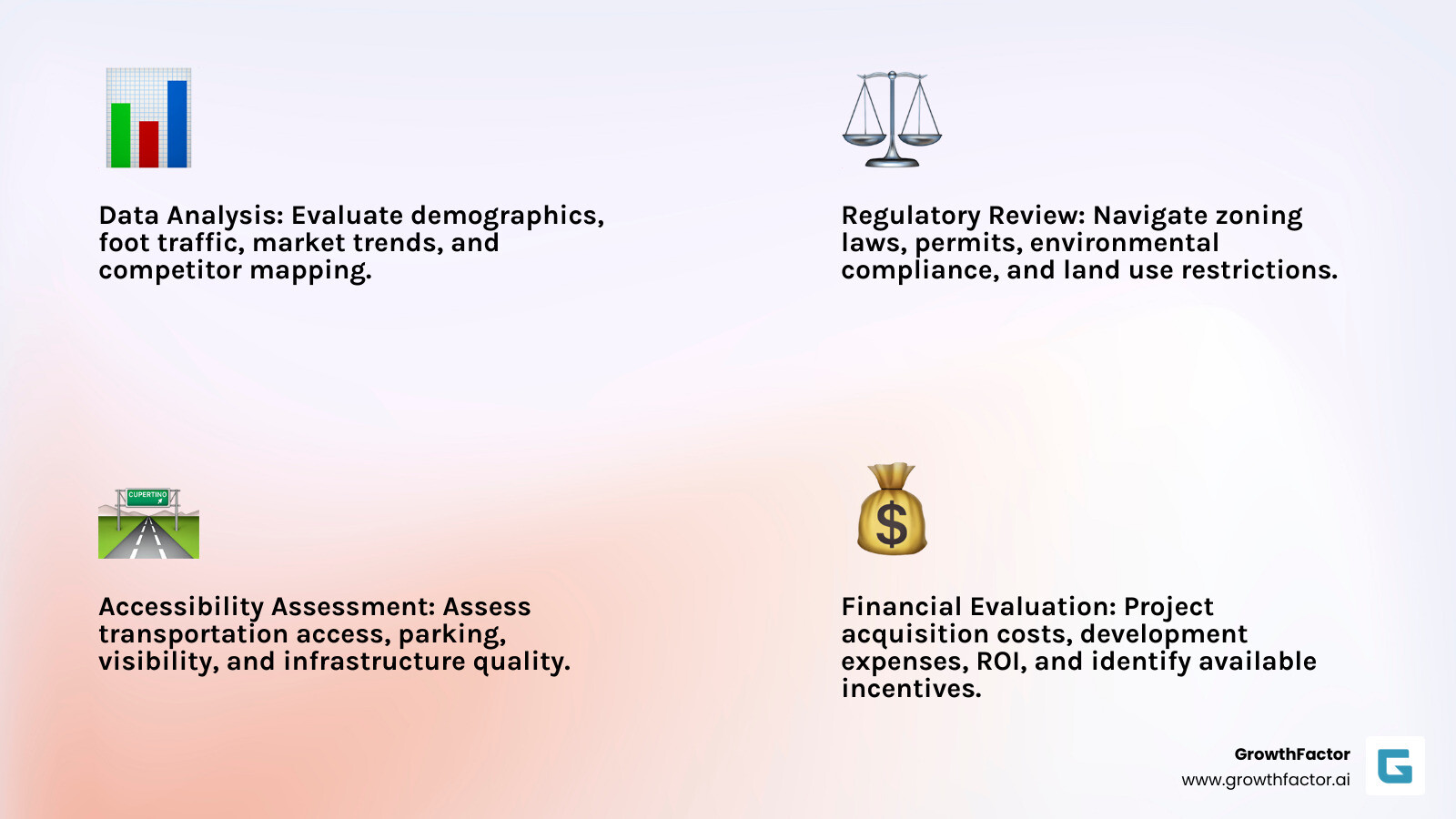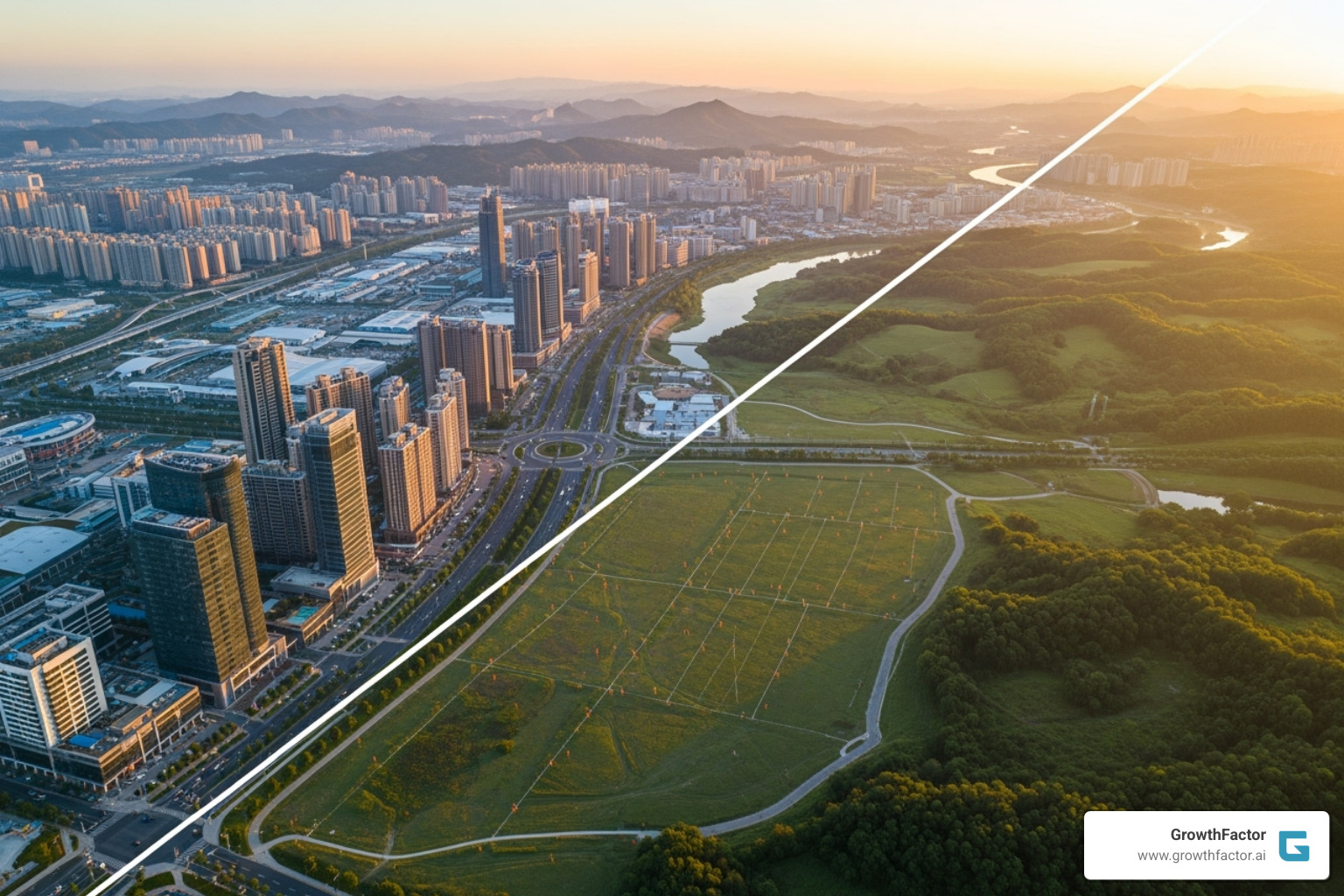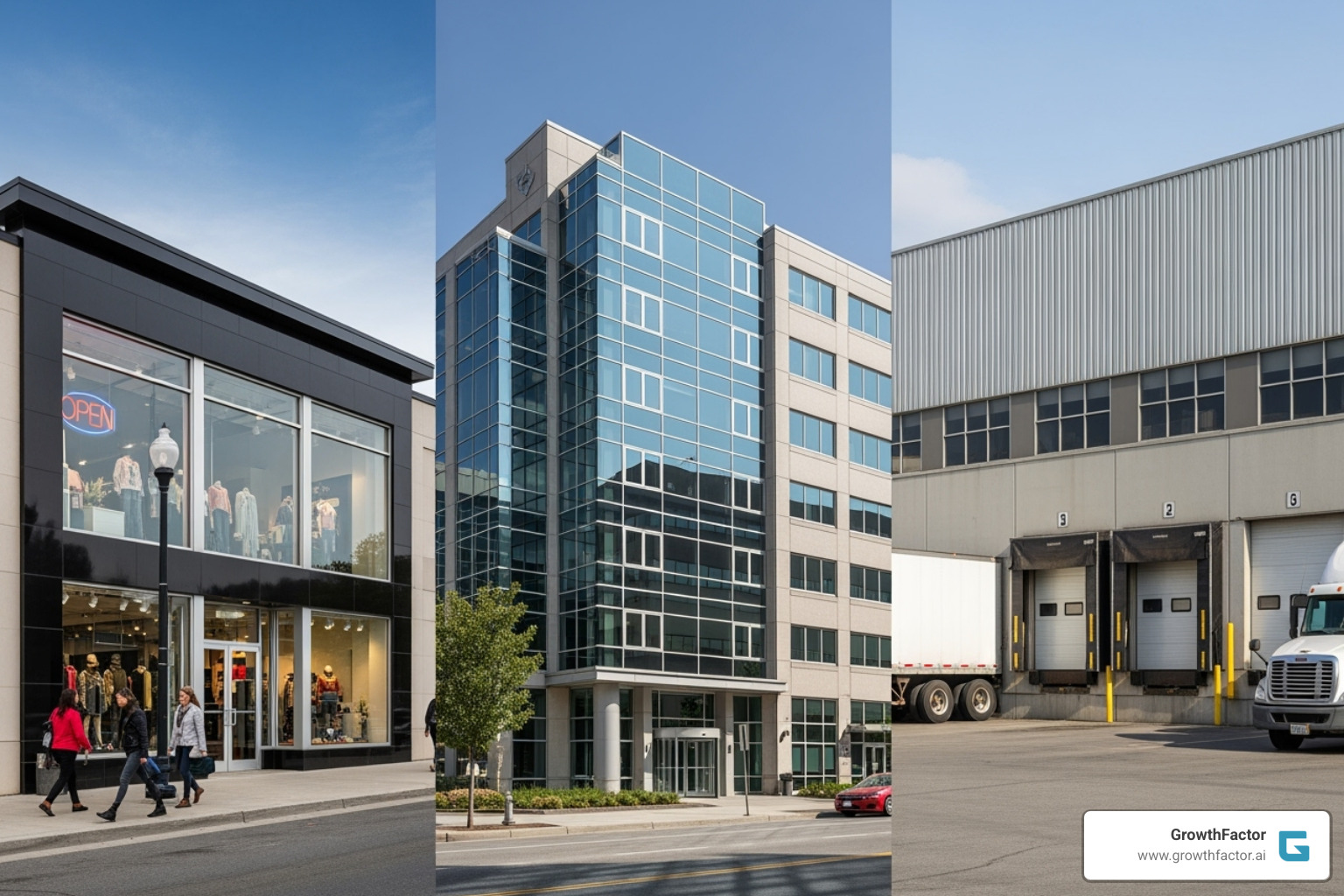Site Unseen? Unpacking the Essentials of Commercial Real Estate Site Selection
Why Your Location is Your Greatest Asset
Site selection real estate is the strategic process of identifying, evaluating, and choosing optimal locations for commercial properties.
Key Components of Site Selection:
- Data Analysis: Demographics, foot traffic, market trends, and competitor mapping
- Regulatory Review: Zoning laws, permits, environmental compliance, and land use restrictions
- Accessibility Assessment: Transportation access, parking, visibility, and infrastructure quality
- Financial Evaluation: Acquisition costs, development expenses, ROI projections, and available incentives
The Site Selection Process:
- Define project needs and criteria
- Screen markets and potential sites
- Conduct detailed evaluations and due diligence
- Perform financial analysis and negotiations
- Execute final acquisition and legal processes
As Warren Buffett noted, site selection is like choosing a spouse—it fundamentally shapes your project's feasibility and success. A strategic location can open up millions of potential customers, while a poor choice can doom even the best business concept.
The stakes are higher than ever. With retail store closures increasing and major bankruptcies creating competitive pressure, retailers need data-driven site selection processes that move at market speed.
The challenge is that traditional methods are slow. A manual evaluation can take hours per site. When 800+ Party City locations hit the market, most retailers couldn't assess them before the auction ended, missing key opportunities.
I'm Clyde Christian Anderson, CEO of GrowthFactor.ai. With over a decade in retail real estate, I've seen how the right location strategy accelerates growth, while manual processes create bottlenecks and cost retailers prime opportunities.

Similar topics to site selection real estate:
The Foundation: Data, Demographics, and Market Analysis
Investing millions based on three-year-old data is a huge risk, yet it's common when relying on traditional sources for site selection real estate. Today, smart developers and retailers combine data analysis with real-world insights. This data-driven approach helps them understand markets, predict consumer behavior, and map competitors with greater accuracy.

The challenge is the lag in traditional data; U.S. Census results can be three years old, missing entire neighborhood changes. That's why professionals now blend multiple data sources with advanced analytics.
Learn more about making informed decisions with Data-Driven Site Selection.
The Role of Data in Site Selection Real Estate
While intuition still matters, modern site selection real estate demands a sophisticated approach that integrates current data, moving beyond gut instinct.
Census data limitations are obvious when there's a 24 to 48-month lag between data collection and publication. You'd miss crucial shifts in demographics and spending patterns.
This is where aggregated mobility data is invaluable, revealing travel patterns and trade areas. However, it has limits. By plotting locations on a flat surface, it can make a busy single-story restaurant appear to have less traffic than a business in a 30-story office building.
Foot traffic analysis fills these gaps by providing granular insights into who visits a location and when. When combined with AI Location Intelligence, we can clean and interpret this data more effectively, building predictive models that work.
Trade area analysis helps define the geographic boundaries of your customer base, which is crucial for identifying market gaps. Combined with robust Site Selection Data, we can forecast sales with remarkable accuracy.
AI is a powerful tool for processing complex datasets. When applied correctly, it enables teams to evaluate more sites while making better-informed decisions. Check out our Sales Forecasting Tips for Retail Site Selection to see how this works.
Understanding Demographics and Market Dynamics
Demographics tell the story of your customers. Successful site selection real estate goes beyond basic stats to include population growth, income levels, employment status, and lifestyle preferences.
Think of demographics as the foundation and market dynamics as the framework. Vacancy rates, rental prices, and competitor analysis reveal market health and opportunities. Sometimes the best locations have few competitors; other times, clustering near complementary businesses creates synergistic benefits.
Markets evolve rapidly. A neighborhood of young professionals five years ago might be dominated by families today—a shift that changes which businesses will succeed. Demographic providers must constantly model these trends from older data.
SWOT analysis helps systematically evaluate these dynamics by examining strengths, weaknesses, opportunities, and threats for each location.
Modern technology is changing this analysis. Real Estate Market Analysis AI can process thousands of data points simultaneously, identifying patterns that would take human analysts weeks to uncover. Combined with strategic planning tools like SWOT Analysis Retail Real Estate, we can make faster, more accurate decisions.
Successful site selection combines powerful data analytics that reveal market opportunities with human expertise that interprets what those opportunities mean for your business goals.
The Blueprint: Navigating Regulations, Accessibility, and Physical Site Factors
Once you have the market data, the next phase is the "art" of site selection real estate: understanding the physical land and navigating the complex regulations that can make or break a project. This phase is about thorough due diligence: evaluating physical suitability, assessing infrastructure, and identifying environmental red flags. It requires on-the-ground verification to gain insights that data alone can't provide.
Zoning, Land Use, and Legal Problems
Zoning ordinances and land use regulations are invisible forces that dictate what you can build, including building types, height, and setback requirements. Getting this wrong is expensive.
The golden rule is to avoid needing a zoning variance. Proceeding "as of right" (with an already permitted use) is faster and cheaper. Seeking variances or special permits adds months or years, plus significant cost and uncertainty.
I've seen projects stumble because developers fell in love with a site before checking the zoning. If a site requires discretionary approval from a local planning board, you're rolling the dice.
Engaging with local authorities early is crucial. Every jurisdiction has its quirks, and understanding the local political landscape can save you headaches. Don't forget to dig into the property's history—any prior zoning issues can signal potential problems.
The SBA offers excellent Guidance on picking a business location that covers many of these regulatory considerations.
Accessibility and Transportation Infrastructure
Location accessibility can make or break your project. If people can't easily get to your site, you're fighting an uphill battle.
Consider proximity to major highways, public transit access, and nearness to airports and ports. For some industrial clients, reaching 40% of the U.S. population within a day's drive is a key factor.
Details like road conditions and infrastructure quality are critical. Difficult ingress and egress can deter customers, and I've seen locations fail simply due to frustrating parking.
Pedestrian traffic patterns tell their own story, especially for retail. You want to understand not just how many people pass by, but their origin and destination. Future transportation projects can also dramatically impact a site's long-term value.
For businesses with significant supply chain logistics needs, transportation infrastructure is even more critical.
Dive deeper into optimizing these factors with Real Estate Location Intelligence.
Environmental and Physical Site Assessment
This is where site selection real estate gets technical and surprises can be expensive. Topography affects construction costs and drainage, while soil quality determines foundation requirements and can reveal contamination. Flood risk assessment is about protecting your investment and ensuring affordable insurance.
Environmental contamination is a developer's nightmare. Thorough environmental assessments and geotechnical studies are non-negotiable to avoid finding issues like old fuel tanks or industrial waste. Remediation costs can easily exceed the property's value.
Don't overlook utility availability—water, power, and broadband are lifelines. In some areas, getting adequate power or high-speed internet can be a significant expense and effort.
Site preparation costs vary wildly depending on these physical characteristics. A site that looks perfect on paper might require extensive work that doubles your budget.
Sustainability and green building practices are increasingly becoming requirements, not just nice-to-haves, in many jurisdictions.
For a comprehensive look at balancing these technical considerations, check out The Developer's Guide to Site Selection.
The Strategic Process of Site Selection Real Estate
Site selection real estate follows a logical sequence from broad vision to specific execution. A structured process prevents costly mistakes. When Party City's 800+ locations became available, retailers with organized processes moved quickly while others scrambled. Speed matters, but so does thoroughness.
The key is balancing data analysis with real-world insights. This combination of analytics and intuition is the foundation for smart decisions.
For a comprehensive walkthrough of this journey, see our guide on the Retail Site Selection Process.
The 5 Key Steps in the Site Selection Process
Step 1: Define Project Needs & Criteria is where everything begins. This initial step is about defining success. It involves clarifying business goals, space requirements, budget, and the target customer profile. Separating must-haves (e.g., zoning, square footage) from nice-to-haves (e.g., architectural style) prevents scope creep and keeps the team focused.
Step 2: Initial Market & Site Screening is where we cast a wide net. Using demographic data, traffic patterns, and competitive intelligence, we identify promising markets and screen for potential sites.
This phase is where technology shines. AI-improved platforms can help evaluate five times more sites efficiently, automating much of the qualification process. Learn more about How AI is Revolutionizing Retail Site Selection.
Step 3: Detailed Site Evaluation & Due Diligence involves physical site visits to verify data and gain on-the-ground insights. We conduct environmental and geotechnical studies to uncover hidden risks and confirm zoning to ensure the proposed use is permitted. The goal is to avoid surprises before committing. Explore Solutions for Site Selection Teams for tools that streamline this process.
Step 4: Financial Analysis & Negotiation shifts focus to the bottom line. We analyze land acquisition costs, site preparation expenses, and projected construction costs. Comprehensive ROI projections ensure the numbers work. Negotiating purchase agreements and securing economic development incentives can significantly impact profitability.
Step 5: Final Acquisition & Legal Execution brings everything home. This involves finalizing contracts, obtaining title commitments, and securing all necessary building permits and approvals. Thorough preparation in earlier steps makes this closing process much smoother.
This systematic approach ensures each step builds on the previous one, creating a predictable and profitable process.
Tailoring Criteria and Overcoming Common Challenges
The truth about site selection real estate is that criteria are not one-size-fits-all. What works for a retail store is a disaster for a warehouse. Successful site selection real estate requires a customized approach for each property type. This is essential for long-term success, especially for growing retailers hitting the "50-location wall," where traditional methods become too slow for rapid expansion.

Learn how to break through this growth barrier at Retail Expansion: Breaking Through the 50-Location Wall.
How Site Selection Varies by Property Type
Different commercial properties require different criteria:
| Property Type | Key Focus Areas | Example Considerations |
|---|---|---|
| Retail | Visibility, Foot Traffic, Demographics, Co-tenancy | Corner locations, proximity to anchor stores, consumer spending habits. How to Choose Retail Location |
| Office | Accessibility for Employees, Talent Pool, Amenities | Commute times, proximity to public transport, nearby restaurants, building tech infrastructure. |
| Industrial/Warehouse | Logistics, Infrastructure, Zoning | Highway/port access, ceiling height, loading docks, power capacity, labor availability. |
| Specialized (e.g., Healthcare, Labs) | Specific Regulations, Proximity to Patients/Partners | Proximity to residential areas, specialized utility needs, compliance with health regulations. |
For retail properties, visibility and foot traffic are king. Complementary neighbors, like a coffee shop next to a bookstore, create synergy. Parking is also crucial; a good rule of thumb is a 3:1 ratio of parking spaces to retail square footage.
For office spaces, the focus is on attracting and retaining talent. Key factors include commute times, public transit access, nearby amenities, and robust tech infrastructure.
For industrial and warehouse facilities, logistics are paramount. Key factors include truck access to loading docks, highway proximity, and capacity for heavy equipment and high electrical loads.
Specialized facilities like healthcare centers have unique demands, including strict regulatory compliance and proximity to specific populations.
Common Challenges in Site Selection Real Estate
Even with the best planning, site selection real estate presents common challenges:
- Competition for prime locations: You're not just competing on price but also racing against time, as the best locations get snapped up quickly.
- Complex and changing regulations: Zoning laws are complex and constantly evolving. Each jurisdiction has unique rules, making early engagement with local authorities essential.
- Hidden environmental issues: Issues like soil contamination or flood risks can add massive costs and delays. Thorough environmental assessments are essential insurance against these problems.
- Inaccurate or outdated data: Census data can be years old, and two-dimensional mobility data can be misleading about actual foot traffic.
- Securing financing and incentives: Navigating federal, state, and local programs requires careful coordination.
- Community opposition: Local residents may raise concerns about traffic or environmental impact. Building relationships early can help mitigate these issues.
The cautionary tale of Forever 21 Bankruptcy: Lessons in Retail Site Selection shows how poor location strategies can impact major brands.
Understanding these challenges allows you to prepare for them, making the process manageable.
Frequently Asked Questions about Commercial Site Selection
What is the most critical factor in real estate site selection?
The most critical factor isn't just "location," but the alignment between the site and your specific project goals. A prime location for a boutique is a disaster for a warehouse. The best location is one where demographics match your target market, accessibility serves your business model, costs fit your budget, and regulations permit your intended use. This holistic approach is key; a less visible site with better parking and lower rent might be the superior choice.
How has technology changed the site selection process?
Technology has transformed site selection real estate from a gut-driven process to a data-driven science. AI and big data analytics process thousands of data points—like mobile location data, consumer spending habits, and competitive density—to reveal previously hidden insights. The main benefit is efficiency. AI can screen hundreds of sites in minutes, freeing up human experts for high-value tasks like negotiations and strategic decision-making. Technology is a powerful tool that augments, not replaces, human judgment. The best strategies combine cutting-edge analytics with experienced professionals.
Learn more about this technological revolution at Real Estate Data Intelligence.
How long does the site selection process typically take?
The timeline for site selection real estate varies dramatically, from a few months to over a year. Key factors include: Project scale (a simple lease takes less time than new construction), market competitiveness (hot markets require speed), and regulatory complexity (zoning variances or environmental issues add significant delays). The required level of due diligence also impacts the timeline. Rushing the process to meet artificial deadlines often leads to poor, costly decisions.
Conclusion: Building Success from the Ground Up
Strategic site selection real estate is the bedrock of your project's success. Like a house's foundation, if it's shaky, the entire structure is at risk.
Successful site selection combines the science of data analysis with the art of human insight. Data reveals trends, but on-the-ground intelligence uncovers issues like drainage problems or news of a major employer moving in—details that data might miss.
The game is changing fast. Traditional methods can't keep pace with market speed. When major chains announce closures, the best sites get snapped up within days.
The future of site selection real estate is about empowering experts with better tools. AI-powered platforms can process vast amounts of data in minutes, screening out mismatches so your team can focus on the most promising opportunities.
At GrowthFactor, we've seen this change firsthand. Our clients are evaluating five times more sites than they could before, finding hidden gems, and making faster decisions with greater confidence.
The retailers and developers who thrive will be those who combine cutting-edge technology with seasoned judgment, moving quickly without sacrificing thoroughness. They'll build success from the ground up, one smart location choice at a time.
Ready to see how intelligent site selection can accelerate your growth? Meet Waldo, the AI Agent for Retail Site Selection and find what's possible when human expertise meets artificial intelligence.
Citations
The human algorithm
Ready to see what we're cooking?
Submit your information below and we'll be in touch to schedule.





